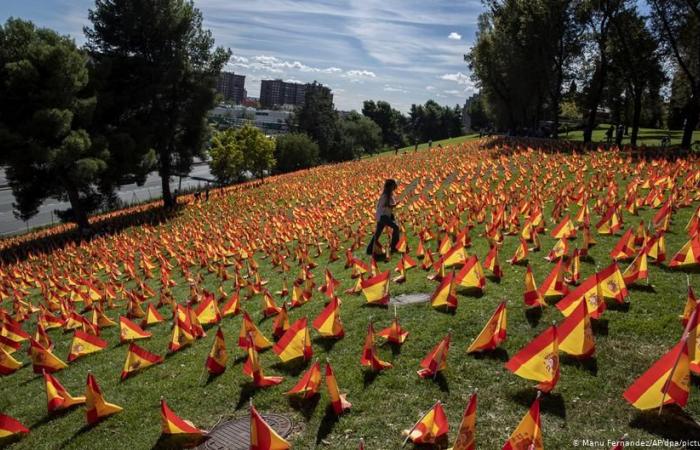Upon his arrival in September 2019, the price of a one-room apartment in the center of the Spanish capital was equal to between 650 and 900 euros for monthly rent. Nothing much has changed in that due to the current economic situation. And Cerda found himself first in the workers’ neighborhood of Paiques in Madrid, where prices have risen by 21 percent in the past four years: “I cared about the atmosphere there.” Here, from March to May, he lives quarantine in a room of six square meters that costs up to 350 euros.
When cohabitation becomes dangerous
“These conditions of life change people, especially in times of epidemic,” says Cerda. The restrictions were – and again also – very strict in Spain. But the numbers of infections remain at a high level, because crowded residential areas have appeared as promoters of viruses, because there are precisely few people sitting at home in front of the computer, but they work in the hospital, in caring for the elderly, in the restaurant, or as a woman in the field of cleaning. And many work Without a license. They cannot stand a positive test, and isolation in housing blocks remains difficult. Catalonia has put an end to that. Years ago, Barcelona, which last year attracted about 30 million foreign visitors, such as Berlin, reduced the number of tourist apartments to open space for housing. Now the ceiling for the rent increase has been set.
A selfie by Pablo Cerda on the Madrid Underground
The regional government there does not distinguish between official and private investors and imposes maximum rent in all cities. This ceiling is especially important in Barcelona, where the housing problem was doubled during the epidemic, as the Dutch Jasper van Dorstein, who lives there, believes: “The problem is not only in the relatively high rent, but also in the conditions that landlords demand, such as paying several months of rent as a guarantee, we do not get. She has to leave if we want to leave. ” This is what the central government changed in the past year and reduced the financial burden on tenants. However, there are still many illegal leases where other rules apply.
All this does not work for the time being against Corona: Even Catalonia took new measures on Wednesday (October 14): hotels are not entitled to receive guests, and bars and restaurants remain closed for fifteen days..
System architecture errors
“There is simply a flaw in our system, ”admits Pedro Abía, a real estate expert at the University of Madrid. Urban spots have risen in price in recent decades:“ Consequently, more social apartments have to be built on public property that is abundantly available abroad. ”According to various estimates, millions of apartments remain in Spain. Empty or not available for sale, including apartments mortgaged with banks due to the previous financial crisis.
These empty buildings mortgaged to the banks are more and more likely to be burgled than others, because foreigners without a work contract or Spaniards with low incomes see no other possibility to obtain housing. Hundreds of thousands of foreigners do not possess valid residence permits.
Desperate wait for guests: a restaurant in Madrid
Old building schemes
In addition, the cost of living in Spain remains only a tiny margin lower than in Germany. The gap between the cost of living and the level of salaries is particularly wide in cities. “Madrid is expensive compared to cities like Paris or Moscow,” says Cerda, who has previously worked and lived in many places in the world. Spain is safer than most of the countries it is in. But here he also sees homeless people and beggars, ugly tall buildings and huge hospitals built next to each other, knowing that Spain has one of the smallest population densities in Europe and it can expand at the periphery. And that people are piled up in tall buildings and companies in industrial zones, as film composer Manuel Piatta explains culturally: “We pile everything up and we love gatherings. Owning a home like me is an exception for a Spaniard. Now during the epidemic I am happy that I live alone in the countryside.“.
But the majority of patients ’beds – about 300 per 100,000 people in Spain – and Germany, according to the European Statistics Office, reach 800 – are in Madrid, Barcelona, Bilbao, Valencia and Seville, not in the countryside where Biata lives. “At least we have an advantage here in Madrid,” Cerda jokes. However, the risk of infection remains high there. It is a vicious circle.
Stephanie Claudia Mueller / M.A.M.
These were the details of the news Why does the Corona epidemic hit Spain hard? | ... for this day. We hope that we have succeeded by giving you the full details and information. To follow all our news, you can subscribe to the alerts system or to one of our different systems to provide you with all that is new.
It is also worth noting that the original news has been published and is available at saudi24news and the editorial team at AlKhaleej Today has confirmed it and it has been modified, and it may have been completely transferred or quoted from it and you can read and follow this news from its main source.


